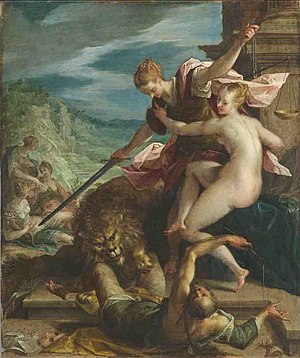
Nicolò dell' Abate, sometimes Niccolò, (1509 or 1512 – 1571) was an Italian painter and decorator. He was of the Emilian school, and was part of the staff of artists called the School of Fontainebleau that introduced the Italianate Renaissance to France.
Niccolò dell'Abbate was born in Modena, the son of a sculptor.
He trained in the studio of a local Modenese sculptor, his early influence including Ferrarese painters such as Garofalo and Dosso Dossi. He specialized in long friezes with secular and mythological subjects, including for the Palazzo dei Beccherie (1537); in various rooms of the Rocca at Scandiano owned by the counts Boiardo, notably a courtly ceiling Concert composed of a ring of young musicians seen in perspective, sotto in su (early 1540s), and the Hercules Room in the Rocca dei Meli Lupi at Soragna (c. 1540–43), and possibly the loggia frescoes removed from Palazzo Casotti at Reggio Emilia.
His style was modified by exposure to notably Correggio and Parmigianino[1], when he moved to Bologna in 1547. In Bologna, most of his painting depicted elaborate landscapes and aristocratic genre scenes of hunting and courtly loves, often paralleled in mythologic narratives. It was during this time that he decorated the Palazzo Poggi, and executed a cycle of frescoes illustrating Orlando Furioso in the ducal palace at Sassuolo, near Modena.
In 1552, Nicolò moved to France, where he worked at the royal Château de Fontainebleau as a member of the decorating team under the direction of Francesco Primaticcio. Within two years of his arrival he was drawing a project for a decor commemorating Anne de Montmorency (preparatory drawing at the Louvre). In Paris, he frescoed the chapel ceiling in the Hôtel de Guise (destroyed), following Primaticcio's designs. He also executed private commissions for portable canvases of mythological subjects sited in landscapes. Much of his output reflected an often overlooked function of artists of the time: the ephemeral festive decorations erected to celebrate special occasions in the court circle, for example, the decorations for the triumphal entry into Paris staged for Charles IX and his bride Elisabeth of Austria in 1571. That year, Nicolò died in France.
Works
Nicolò is best known for his landscapes enshrouding a mythologic narrative, a thematic which would inspire Claude Lorrain and Nicolas Poussin, and for his profuse and elegant drawings. The Chambers Biographical Dictionary says of him, "Few of his frescoes are extant, but the Louvre has a collection of his drawings."[2]










